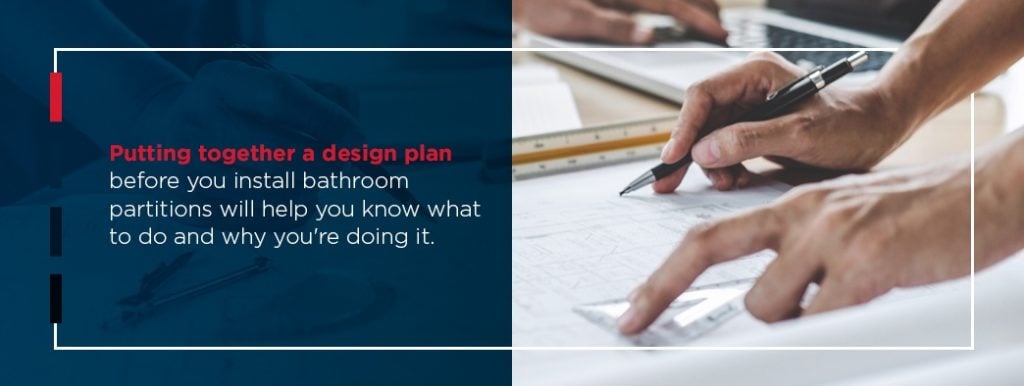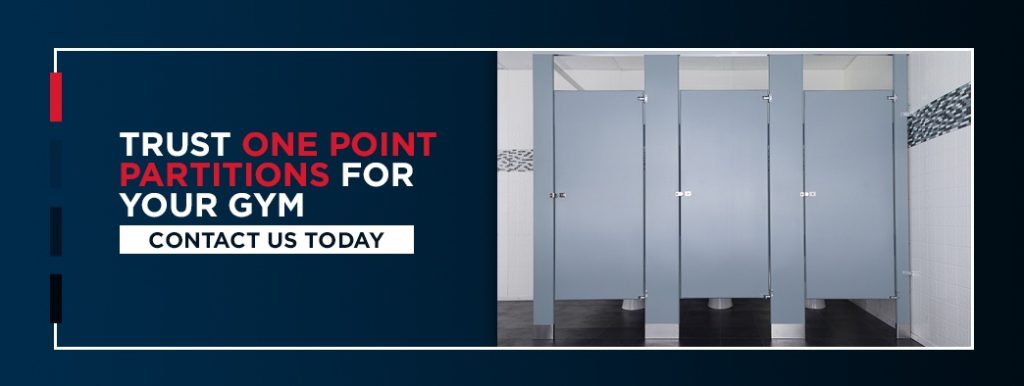Tips For Selecting Bathroom Partitions For Your Gym
The bathrooms at your gym see a lot of use. People change from workout clothes into street clothes in them, shower in them, and generally get ready for a workout or a return to their other activities. When you’re looking to outfit the bathroom of your gym with new toilet partitions, it’s important to think about moisture resistance, privacy, and appearance.

If you need help knowing what to look for in gym bathroom partitions, look no further. Keep reading to learn the different material options for gym bathroom partitions, how to choose the best one for your space, and tips for a successful installation.
Choosing the Right Partition Material
Ideally, the material you select for your commercial bathroom partitions will be bacteria and moisture resistant, and able to withstand a lot of use.
Some materials are better suited for gym bathroom partitions than others. Take a look at the options available:
- Solid Plastic: Solid plastic bathroom partitions are nonporous, which makes it easy to keep clean. They can handle high levels of moisture without rust or corrosion. Solid plastic partitions are durable and sturdy. One Point Partitions offers solid plastic partitions in 16 color options, including neutrals and bold hues.
- Phenolic: Phenolic partitions are a premier choice for your bathroom. They are made of a solid resin core covered with a layer of melamine, which resists moisture. Phenolic partitions are durable and withstand high traffic. The partitions do well in areas with a lot of steam and do not warp when cleaned. One Point Partitions offers 13 styles of phenolic partitions.
- Stainless Steel: Stainless steel partitions are highly sought-after due to their timeless, sleek design. They look good with any bathroom design. Stainless steel is sturdy, versatile, and easy to maintain. It is also the most environmentally-friendly partition material available.
- Laminate: Laminate partitions are a popular choice because they are budget-friendly and boast the most color options available. One Point Partitions offers 48 different laminate styles — something for every taste. As always, our laminate partitions are all American-made.
- Powder-Coated Steel: Powder-coated steel has the lowest price point of any partition material. These partitions are also durable and rust-resistant. Powder-coated steel is easily adaptable to various bathroom shapes and layouts. Powder-coated steel partitions are available in 15 colors.
If the conditions in a bathroom are very humid, solid plastic is often the best pick for partitions, because it performs the best in wet areas. Phenolic is another top pick for high-humidity gym bathrooms, as it features many of the same qualities of solid plastic.
Although stainless steel, laminate, and powder-coated steel partitions are the perfect choices for some bathrooms, they are not ideal for bathrooms with high humidity levels. You can still choose partitions made of these materials for your gym bathroom if moisture levels are not high — one of our professionals will be glad to help you make that decision during a free design consultation.
Installing Your Gym Bathroom Partitions
Before you begin installing gym bathroom partitions, you should create the design, prepare your workspace and gather all necessary equipment. Have a locker room? Check out the locker room partitions we offer as well!
Create The Design
Putting together a design plan before you install bathroom partitions will help you know what to do and why you’re doing it. It’s important to create a design of your bathroom with exact dimensions. Include the direction and distance of the door swing, the location of any existing partitions, sinks, and other bathroom fixtures.

You can input the information into our online design tool to help simplify the process of designing your bathroom. The tool will take into account your bathroom’s dimensions and the number of partitions you want to create a design that fits your space.
The size of your partitions will differ based on your bathroom’s layout and available space. A standard bathroom stall is 36 inches wide and 60 inches deep. The depth of a stall varies from 48 inches to 78 inches.
To maintain ADA compliance, all new-construction square restroom stalls must have out-swinging doors and no more than four inches of space between the diagonal corner and the toilet. The toilet needs to be between 16 and 18 inches center from the closest wall or partition. Compartments must be a minimum of 60 inches wide and 59 inches deep, with a 34 or 36-inch door for easy wheelchair access. Ambulatory access stalls should be a minimum of 36 inches wide and have a handicap door.
After you have created a drawing and selected the material for your partitions, submit it to our experts to request a free quote.
Prepare Your Work Area
Prepare your work area for installation by clearing away old partitions, filling any holes in the wall and floor, and cleaning the area thoroughly. Before you begin with any drilling or anchoring, you will need to plan and measure everything precisely. Use your layout guide to mark your partition dimensions with pencil and chalk lines. You need to establish where the front of the stall will be — accounting for the width of the stiles and doors — as well as the distance from the wall and the location of wall anchors.
Always go over your measurements twice to ensure accuracy before you begin the installation.
Gather Necessary Equipment
When you receive your partitions, they will come in three separate parts — panels, doors, and pilasters — plus all necessary hardware. Panels refer to the flat surfaces that make up your partition. Pilasters are the stiles used to connect the doors to the panels. Hardware includes screws, anchors, and multiple types of brackets.
You will also need installation tools, including:
- Tape measure and pencils
- Center punch
- Drill and drill bits
- Screwdriver and bit heads
- Torx screwdriver
- Shims
- Level
- Adjustable wrench
- Allen wrenches
- Hacksaw
- Hammer
The Installation Process
Each type of bathroom partition requires a slightly different installation process. You can hire a professional to install your partitions for you, or you can take advantage of our simple step-by-step installation instructions. For each type of partition material — solid plastic, phenolic, stainless steel, laminate, and powder-coated steel — there is a corresponding video showing you how to handle the installation without a need for a professional.
Cleaning Tips For Gym Bathroom Partitions
Regular maintenance and thorough bathroom cleaning is essential for the health and safety of your patrons and will prevent mold or mildew from taking hold.
No matter the material, keeping your partitions clean is simple. Never use harsh chemicals or abrasive materials on your partitions — warm water and gentle detergent will do the job and preserve the integrity of your partition.
- Solid Plastic: Solid plastic partitions can be easily hosed down during cleaning. They will not warp. Standard, gentle cleaning solutions will keep your solid plastic in top shape. If your solid plastic partition is scratched, remove the markings by rubbing a heated spoon in the direction of the grains, applying firm pressure.
- Phenolic: Standard cleaning solutions will usually do the job for phenolic partitions — however, if there is graffiti to remove, you may need a dedicated graffiti cleaner. If your phenolic partitions are textured, use a soft-bristled brush to scrub the surface gently.
- Stainless Steel: Stainless steel is an excellent choice for a bathroom — but due to its reflective nature, daily wipe-down is recommended. Never use cleaners with bleach, acid or alkali for stainless steel. Instead, use a just-damp cloth and cleaning solution and clean in the direction of the grains. Finish with stainless steel polish.
- Laminate: Abrasive cleaning agents will discolor laminate. Stick to mild detergents and use a gentle scrubbing motion. If necessary, use a stronger cleaning product made with acetic acid. Protective wax can help maintain the appearance of your laminate partitions.
- Powder-coated Steel: Powder-coated steel is easily cleaned with warm water and steel-safe detergents. Make a note to apply a layer of wax sealant for maximum protection regularly.
![]()
Use Our Pricing Tool
Try out our new pricing tool and get prices without the wait in 3 easy steps!










